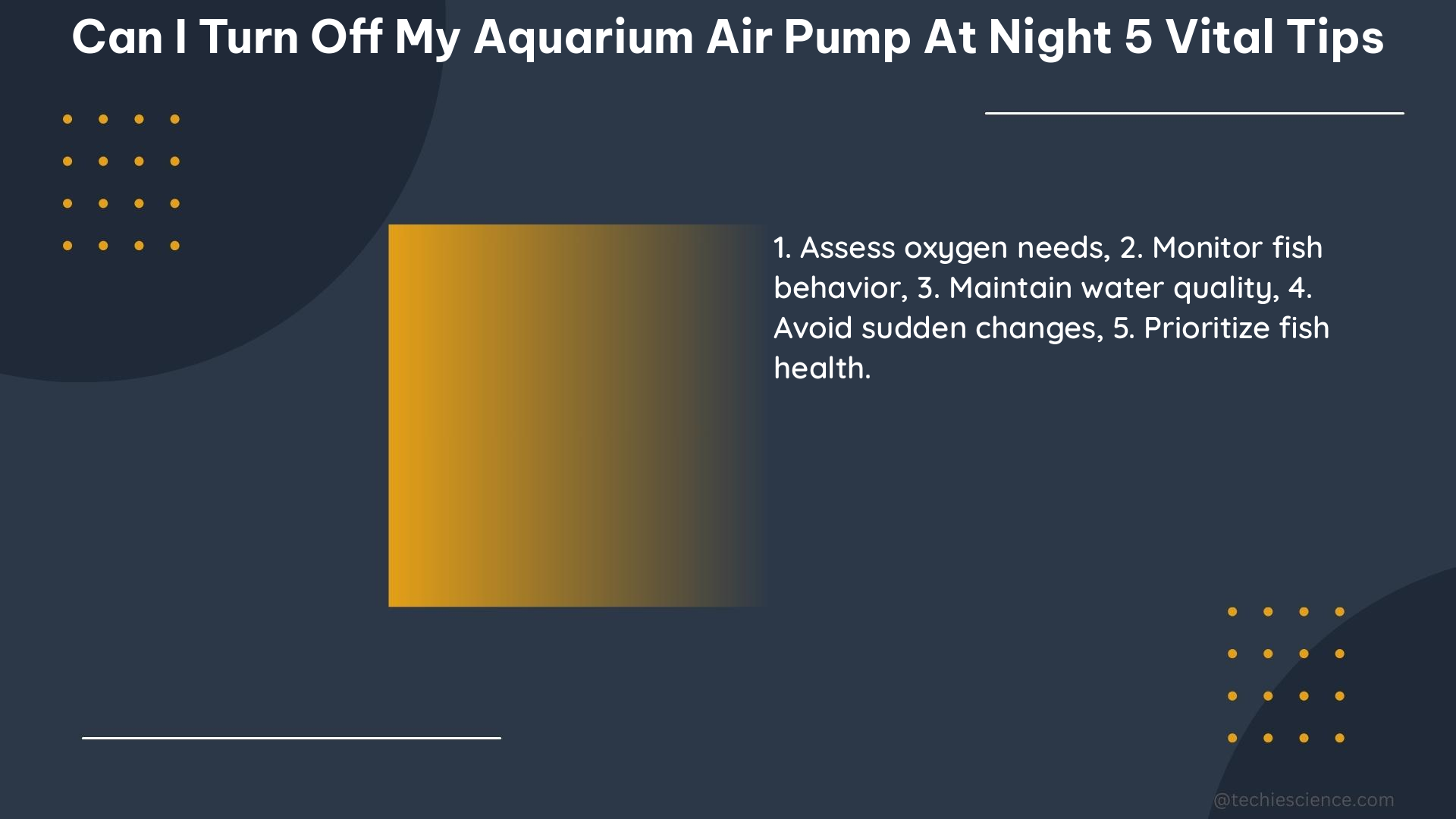Summary
Turning off your aquarium air pump at night can have significant consequences for the health and well-being of your fish and invertebrates. This comprehensive guide explores 5 vital tips to consider before making this decision, including the impact on oxygen levels, filtration, and water circulation, as well as methods to reduce noise and minimize power consumption. Additionally, a detailed DIY solution for building a silent air pump enclosure is provided, along with technical specifications and references to help you make an informed decision.
Fish and Invertebrate Health

Maintaining adequate oxygen levels in your aquarium is crucial for the health and survival of your fish and invertebrates. Turning off the air pump at night can lead to a significant drop in dissolved oxygen, which can stress and potentially harm your aquatic inhabitants, especially those that require high oxygen levels, such as some LPS (large polyp stony) and SPS (small polyp stony) corals.
To ensure your aquatic life receives sufficient oxygenation, it’s essential to maintain a well-planted aquarium with good surface agitation. This can be achieved through the use of powerheads, wavemakers, or other water circulation devices that create surface movement and facilitate gas exchange between the water and the air.
Filtration and Water Circulation
In addition to oxygenation, the air pump also plays a crucial role in maintaining proper water circulation and filtration within your aquarium. Turning off the air pump can disrupt the nitrogen cycle and negatively impact water quality, as the lack of water movement can lead to the accumulation of waste and detritus.
To maintain adequate water flow, consider using alternative circulation methods, such as powerheads or wavemakers, which can operate more quietly than air pumps. These devices can help ensure that your aquarium’s filtration system continues to function effectively, even with the air pump turned off.
Noise Reduction
If the primary concern is the noise generated by the air pump, there are several methods you can employ to reduce the disturbance without turning it off completely. Placing the air pump on a sound-absorbing material, such as a rubber mat or dense foam, can help dampen the vibrations and minimize the noise.
Another effective solution is to enclose the air pump in a soundproof box or wrap it in noise-reducing materials, such as acoustic foam or dense fabric. This can significantly reduce the audible impact of the air pump, allowing you to maintain its operation without disrupting your aquarium’s environment.
Power Consumption
While turning off the air pump at night may result in some energy savings, the overall impact on your electricity bill is likely to be minimal. A typical aquarium air pump consumes around 5-10 watts of power, which is relatively low compared to other household appliances.
For example, leaving a 100-watt light bulb on for 8 hours a day would consume 20 times more energy than an air pump operating continuously. Therefore, the potential energy savings from turning off the air pump may not justify the potential risks to your aquarium’s ecosystem.
DIY Solution – Building a Silent Air Pump Enclosure
If you’re looking for a more permanent solution to the air pump noise issue, you can consider building a silent air pump enclosure. This DIY project involves creating a soundproof box that houses the air pump, effectively reducing the noise and vibrations without compromising its functionality.
Materials Needed:
- A sturdy, soundproof material (e.g., MDF, plywood, or acoustic foam)
- Sound-absorbing insulation (e.g., acoustic foam, mineral wool, or fiberglass)
- A quiet air pump (e.g., one that operates below 40 dB)
- A power strip or timer to control the air pump’s operation
Instructions:
- Cut the soundproof material to create a box that fits snugly around the air pump.
- Line the interior of the box with sound-absorbing insulation, ensuring that the air pump’s vibrations are absorbed.
- Cut a hole in the box for the airline tubing and secure it with a grommet to prevent air leaks.
- Place the air pump inside the box, connect the airline tubing, and secure the lid.
- Plug the air pump into a power strip or timer to control its operation.
Technical Specifications
- Air Pump Noise Level: Aim for an air pump with a noise level below 40 dB to minimize disturbance.
- Air Pump Power Consumption: A typical aquarium air pump consumes around 5-10 watts of power.
- Water Flow Rate: For a 250-gallon (1 m3) aquarium, maintain a water flow rate of at least 10 times the tank’s volume per hour (i.e., 2500 GPH or 9500 LPH).
References
- Turn air/circulation/filtration off at night? – Aquarium Forum
- Is It Bad To Unplug Air Pump At Night? | FishLore Aquarium – FishLore
- How to turn off aquarium air pump at night? #AquariumAirPump – LinkedIn
- Can I turn off the air pump at night? Please read. – Aquarium Advice
- Could I turned off the air pump during the day – Reddit
